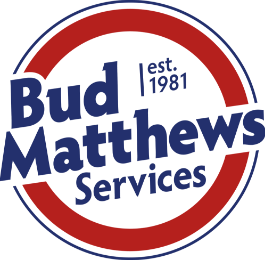
Updated May 2022
The CDC reports that the air quality in your home may be more polluted than the outside air. This can increase the severity and frequency of allergy attacks. After reading this Bud Matthews.
Services blog on indoor air contaminants, you’ll be able to identify:
- The most frequent pollutants in your home
- The physical symptoms that may accompany poor indoor air quality
- The best way to minimize or eliminate the symptoms
Dirt, dust, pet dander, bacteria, and mold are among the most common reasons for poor indoor air quality. Many of these are odorless, so it may be challenging to determine what is triggering your respiratory issues. Symptoms of poor air quality are often mistaken for a cold, allergies, stress, or the flu. However, if the following symptoms fade when you leave a specific location, they may be a sign of pollutants in your home:
- Headaches
- Nasal congestion
- Coughing
- Sneezing
- Fatigue
- Hypersensitivity
- Rash
- Irritations of the throat, skin, and nose
Here are some tips from Bud Matthews Services that can help you remove the pollutants most commonly found in Chapel Hill homes.
Dust
Dust is a generic term that refers to the cocktail of tiny pollutants in your home, such as dirt, soot, pollen, pet dander, dust mites, human skin, lint, and various other particles. Dust can be found anywhere, from the top of your refrigerator to underneath the sofa and everywhere in between. It often collects in upholstered surfaces, such as furniture, pillows, and draperies. These particles contain allergens that can make you sick. You may want to use a mask to minimize the amount of dust you breathe as you clean.
Start at the top of the room and work your way down. Wipe down the blades of ceiling fans, window and door casings, bookcases, and similar surfaces with a clean cloth. If you are using a regular cotton cloth and not one made to attract dust, you can spray the surface with a water or cleaning solution so that the dust doesn’t float away.
Use the upholstery attachment on your vacuum and carefully run it along any draperies. Wipe down any artwork, photos, and collectibles. Air vents, baseboards, blinds, and shutters can be vacuumed or dusted. Vacuum fabric-covered sofas and chairs, starting at the top and using a left to right motion as you work your way down.
If possible, remove the cushions to clean underneath them and in the crevices. You may have to go over deep pile carpets with a vacuum more than once. Take area rugs outside and use a carpet beater to remove the dust from your home and help keep them looking new.
The air filters in your home trap the particles that travel through the ductwork, reducing the spread of airborne contaminants. Change them quarterly to maintain effectiveness and prevent buildup of pollutants in your home
Dirt
Dirt is a mix of clay, rocks, sand, and organic substances, such as decomposed plant and animal matter. The precise makeup of the dirt depends on where you live and where you’ve been. For example, dirt in a Carrboro home may be different from the dirt found in Research Triangle Park (RTP) or even Chapel Hill.
Minimize the potential mess by having a doormat outside and inside to trap dirt and prevent it from entering and spreading throughout your home. A shoe stand or boot tray at the door can remind visitors and family members to remove their shoes and make cleaning easier, especially after a storm. Consistently sweeping and mopping solid surface floors and vacuuming the corners is the best way to reduce the overall amount of dirt in your home.
Pet Dander
There are many joys of having a pet, from unconditional love and stress relief to emotional support. However, if you have allergies or sensitivity to pollutants in your home, they may make it challenging to have a pet. Dander is the build-up of tiny particles shed by animals with fur or feathers. Dander can come from most cats, dogs, parrots, and other pets.
Bathing and brushing your pet regularly can help spread the natural oils throughout the skin, which reduces shedding and dead skin flakes that cause dander. If you can take your pet outside, it can reduce the overall contaminants in your home. Routine vacuuming, mopping, and dusting can help minimize the amount on the carpets and solid surfaces. A lint brush or roller taken to the furniture and draperies can remove pet dander from upholstered items.
At Bud Matthews Services, we recommend air purifiers with HEPA filters to help remove tiny particles from the air, whether you have a tabletop purifier in the bedroom or a larger unit in the central family and living areas. If you have the worst symptoms at night, you may need to keep your pet off the bed, vacuum the mattress and launder the bedding, including the pillows, more often and use hot water.
Bacteria
Wet surfaces, kitchen workstations, and warm moist environments in Chapel Hill are breeding grounds for all kinds of bacteria, such as:
- Salmonella
- Staphylococcus
- E. coli
- Campylobacter
However, germs can spread on virtually any surface you touch frequently. Cellphones, tablets, keyboards, and television remotes can become home to thousands of bacteria.
Reduce the pollutants in your home by sanitizing your kitchen sponge and disinfecting the counters, floors, and fixtures a few times a week. Frequent washing can keep the germ count down and your surfaces sparkling. Wiping your electronics weekly with a wrung disinfecting wipe not only minimizes bacteria but also can add to the usable lifespan of the item.
Bath towels hold fungi, dead skin cells, and body secretions from the first use. When you use the towels multiple times between washes, bacteria build quickly. Laundering towels after every third use and ensuring they air dry thoroughly can help keep germs at bay. Washing the bed sheets weekly and using a waterproof allergy barrier helps keep the bacteria to a minimum and prevent allergy symptoms.
Mold
Mold thrives in damp environments, making its home in showers, sinks, and other moist areas. If you detect a musty odor in your bathroom, kitchen, or basement, you may have a high concentration of mold. Washing non-porous surfaces with a mixture of water and distilled white vinegar can break down the structure of the mold, killing it.
Borax and baking soda are both non-toxic and have a high pH which inhibits the growth of mold. Mixing with water and rubbing the surface can help you get rid of mildew. If the mold has caused stains, you may want to use borax, a more potent cleaning product.
If mold has left dark stains or is a particularly stubborn strain, household bleach can destroy it and remove discoloration. Due to its toxicity, you should dilute it before use.
Learn More Today
Cleaning the air ducts in your home twice a year can reduce the pollutants in your home and prevent spreading them throughout the whole house. This can help you avoid symptoms associated with allergies and improve indoor air quality.
In addition to preventive maintenance, duct repair, and sealing, we also install air purifiers, filtration systems, and dehumidifiers. Contact Bud Matthews Services today to schedule a consultation. We service Carrboro, Northern Chatham County, and the entire Chapel Hill area.

